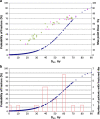Predictors of radiotherapy induced bone injury (RIBI) after stereotactic lung radiotherapy
- PMID: 22985910
- PMCID: PMC3534507
- DOI: 10.1186/1748-717X-7-159
Predictors of radiotherapy induced bone injury (RIBI) after stereotactic lung radiotherapy
Abstract
Background: The purpose of this study was to identify clinical and dosimetric factors associated with radiotherapy induced bone injury (RIBI) following stereotactic lung radiotherapy.
Methods: Inoperable patients with early stage non-small cell lung cancer, treated with SBRT, who received 54 or 60 Gy in 3 fractions, and had a minimum of 6 months follow up were reviewed. Archived treatment plans were retrieved, ribs delineated individually and treatment plans re-computed using heterogeneity correction. Clinical and dosimetric factors were evaluated for their association with rib fracture using logistic regression analysis; a dose-event curve and nomogram were created.
Results: 46 consecutive patients treated between Oct 2004 and Dec 2008 with median follow-up 25 months (m) (range 6 - 51 m) were eligible. 41 fractured ribs were detected in 17 patients; median time to fracture was 21 m (range 7 - 40 m). The mean maximum point dose in non-fractured ribs (n=1054) was 10.5 Gy ± 10.2 Gy, this was higher in fractured ribs (n=41) 48.5 Gy ± 24.3 Gy (p<0.0001). On univariate analysis, age, dose to 0.5 cc of the ribs (D0.5), and the volume of the rib receiving at least 25 Gy (V25), were significantly associated with RIBI. As D0.5 and V25 were cross-correlated (Spearman correlation coefficient: 0.57, p<0.001), we selected D0.5 as a representative dose parameter. On multivariate analysis, age (odds ratio: 1.121, 95% CI: 1.04 - 1.21, p=0.003), female gender (odds ratio: 4.43, 95% CI: 1.68 - 11.68, p=0.003), and rib D0.5 (odds ratio: 1.0009, 95% CI: 1.0007 - 1.001, p<0.0001) were significantly associated with rib fracture.Using D0.5, a dose-event curve was constructed estimating risk of fracture from dose at the median follow up of 25 months after treatment. In our cohort, a 50% risk of rib fracture was associated with a D0.5 of 60 Gy.
Conclusions: Dosimetric and clinical factors contribute to risk of RIBI and both should be included when modeling risk of toxicity. A nomogram is presented using D0.5, age, and female gender to estimate risk of RIBI following SBRT. This requires validation.
Figures






Similar articles
-
Assessment of Monte Carlo algorithm for compliance with RTOG 0915 dosimetric criteria in peripheral lung cancer patients treated with stereotactic body radiotherapy.J Appl Clin Med Phys. 2016 May 8;17(3):277-293. doi: 10.1120/jacmp.v17i3.6077. J Appl Clin Med Phys. 2016. PMID: 27167284 Free PMC article.
-
Radiation-induced rib fractures after hypofractionated stereotactic body radiation therapy of non-small cell lung cancer: a dose- and volume-response analysis.Radiother Oncol. 2009 Jun;91(3):360-8. doi: 10.1016/j.radonc.2009.03.022. Epub 2009 May 4. Radiother Oncol. 2009. PMID: 19410314
-
Radiation-induced rib fracture after stereotactic body radiotherapy with a total dose of 54-56 Gy given in 9-7 fractions for patients with peripheral lung tumor: impact of maximum dose and fraction size.Radiat Oncol. 2015 Apr 22;10:99. doi: 10.1186/s13014-015-0406-8. Radiat Oncol. 2015. PMID: 25897487 Free PMC article.
-
Risk-adapted robotic stereotactic body radiation therapy for inoperable early-stage non-small-cell lung cancer.Strahlenther Onkol. 2018 Feb;194(2):91-97. doi: 10.1007/s00066-017-1194-x. Epub 2017 Aug 15. Strahlenther Onkol. 2018. PMID: 28812120 Review. English.
-
Pathological vertebral fracture after stereotactic body radiation therapy for lung metastases. Case report and literature review.Radiat Oncol. 2012 Mar 28;7:50. doi: 10.1186/1748-717X-7-50. Radiat Oncol. 2012. PMID: 22455311 Free PMC article. Review.
Cited by
-
Differences in rates of radiation-induced true and false rib fractures after stereotactic body radiation therapy for Stage I primary lung cancer.J Radiat Res. 2015 Mar;56(2):332-7. doi: 10.1093/jrr/rru107. Epub 2014 Dec 11. J Radiat Res. 2015. PMID: 25504640 Free PMC article.
-
Predictors and characteristics of Rib fracture following SBRT for lung tumors.BMC Cancer. 2023 Apr 12;23(1):337. doi: 10.1186/s12885-023-10776-8. BMC Cancer. 2023. PMID: 37046249 Free PMC article.
-
Modeling the effects of radiation on the bone tumor microenvironment: opportunities for exploring combination therapies in microphysiologic systems.Cell Mol Biol Lett. 2025 Aug 14;30(1):97. doi: 10.1186/s11658-025-00774-y. Cell Mol Biol Lett. 2025. PMID: 40813975 Free PMC article. Review.
-
Exploratory analysis using machine learning to predict for chest wall pain in patients with stage I non-small-cell lung cancer treated with stereotactic body radiation therapy.J Appl Clin Med Phys. 2018 Sep;19(5):539-546. doi: 10.1002/acm2.12415. Epub 2018 Jul 10. J Appl Clin Med Phys. 2018. PMID: 29992732 Free PMC article.
-
The evolving toxicity profile of SBRT for lung cancer.Transl Lung Cancer Res. 2019 Feb;8(1):48-57. doi: 10.21037/tlcr.2018.10.06. Transl Lung Cancer Res. 2019. PMID: 30788234 Free PMC article. Review.
References
-
- Pettersson N, Nyman J, Johansson KA. Radiation-induced rib fractures after hypofractionated stereotactic body radiation therapy of non-small cell lung cancer: a dose- and volume-response analysis. Radiotherapy and oncology: journal of the European Society for Therapeutic Radiology and Oncology. 2009;91(3):360–368. doi: 10.1016/j.radonc.2009.03.022. - DOI - PubMed
-
- Voroney JP. et al.Chest wall pain and rib fracture after stereotactic radiotherapy for peripheral non-small cell lung cancer. Journal of thoracic oncology: official publication of the International Association for the Study of Lung Cancer. 2009;4(8):1035–1037. doi: 10.1097/JTO.0b013e3181ae2962. - DOI - PubMed
Publication types
MeSH terms
LinkOut - more resources
Full Text Sources
Medical
Research Materials

